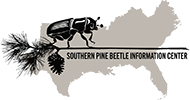Abstract
The seasonal trends of Dendroctonus frontalis Zimmermann attack on, and survival in, pines were studied. Estimates of beetles attacking, egg gallery length, 3rd and 4th instars, pupae, and beetles emerging were obtained for a total 113 loblolly pines, Pinus taeda L. The estimates were used to calculate the percentages of each of the following: eggs that survived to become 3rd and 4th instars, SE; 3rd and 4th instars that survived to become pupae, SL; pupae that survived to emerge as beetles, SP; and, eggs that survived to emerge as beetles, SO. The sizes and seasonal trends of SE, SL, SP, and SO changed during the 3-yr period studied. SE, SL, SP, and SO all decreased during the summer, but SL decreased most predictably. Trends in SO followed the trends in SL most closely. Indices of temperature and rainfall were calculated from the daily records of weather stations. Only SL and SO were associated with temperature and rainfall indices. The most useful indices in regression equations describing SL and SO were day-degree accumulation, DD, and the proportion of the infestation period when 0.6 cm or more of rain fell per day, PR. Increases in DD and PR were associated with decreases in SL and SO. It is suggested that DD and PR were the most useful indices because they measure both the size and the duration of temperature or rainfall.
